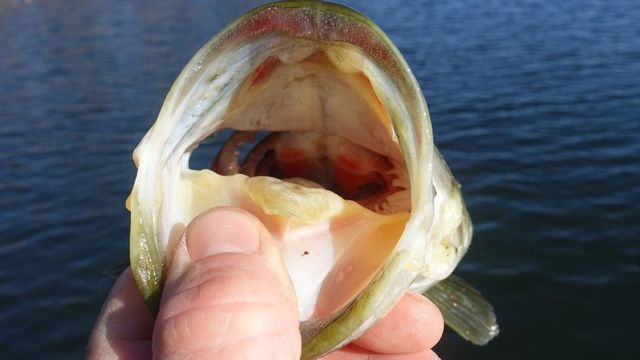
4 Bass Lures You NEED In Your Winter Tackle Box
Winter fishing can be both hard and easy for bass anglers. The hard part is trying to stay warm and keep your equipment from freezing up in the cold. The easy part is lure selection becomes much simpler because bass are lethargic in the winter so you can narrow down your choices to slower moving baits.
Wearing the proper clothing will protect you from the cold but keeping your equipment from freezing up is still a hardship you will have to endure in the winter. Although the cold water slows down a bass’ metabolism the fish still has to eat so you just have to figure out the best ways to coax bass into biting.
Here are four ways to catch bass throughout the winter:
1) Jerkbaits
Bass move off the bottom and suspend away from the bank after a cold snap hits and high pressure settles in your area. Twitching a suspending stickbait becomes the ideal tactic for this situation because you can let the lure sit suspended in front of a bass long enough that the fish will come up and investigate it.
Varying the retrieve helps you determine how bass want the stickbait presented. Twitching the lure two or three times and then letting it pause is the best presentation for suspended bass. The mood of the fish each day determines whether you should pause the lure ranging from two to 25 seconds.
A variety of 4- and 5-inch suspending stickbaits in shad patterns will trick wintertime bass. The lure is most productive when worked over large rocks, bluff ends, 45-degree banks or brush piles. You can throw the stickbait on 6-, 8- or 10-pound fluorocarbon to the bank or over brush and reel it down to its maximum depth.
2) Alabama rigs
This multi-lure rig produces strikes from wintertime bass because it imitates a small school of shad that has broken away from a large school of shad. A large school of shad can be intimidating to bass sometimes so the Alabama rig with a handful of swimbaits looks like an easier target for bass.
Your state’s law on umbrella rigs will determine how many lures you can attach to the rig. My home state of Missouri allows only three hooks on an Alabama rig, so I put three swimbaits with 1/8-ounce jigheads on the center and bottom wires of the rig and attach two “dummy lures” without hooks on the top wires.
I set up my rig with 3 1/2- to 4-inch swimbaits in shad colors such as a gray body with a black back. I throw the rig on 65-pound braid line in stained water or 25-pound monofilament in clear water.
The rig can be retrieved slowly along steep channel banks or over brush piles or pole timber down to 30 feet deep. Let the rig sink to the bottom before slowly retrieving it, or check your electronics to see how deep bass are and try to steadily retrieve the rig slightly above the fish.
3) Blade Baits
10,000 Fish Death StalkerShop Blade Baits And Spoons
A heavy metal bait such as a Death Stalker thrown on 15-pound fluorocarbon line excels in the winter because it can probe deep and catch bass in the 30- to 40-foot range. Steep drop-offs along main and secondary points or creek channels in major coves are the prime spots to introduce a heavy metal bait to bass.
A 1/2-ounce lure works best for depths under 20 feet and a 3/4-ounce model is better for probing deeper than 20 feet. After making a long cast, let the lure to sink to the bottom on a slack line before starting your retrieve. Lift the bait just enough to where you can feel it vibrate, then let the lure pendulum towards you to imitate the action of a dying shad.
4. Football Jigs
A football jig is ideal for winter bass because the lure can be dragged slowly to imitate crayfish crawling along rocky bottoms.
A 3/4-ounce football jig tipped with a soft plastic chunk or double tail plastic grub is best for dragging at depths greater than 20 feet. Select jigs and trailers that best resemble crayfish hues such as brown and green pumpkin.
Cast the jig on 12- to 16-pound fluorocarbon line and let it sink to the bottom. Employ a slow drag similar to working a Carolina rig and alter the distances you drag the lure. Slowly drag the jig 2 to 4 feet before stopping it and shorten the drag to 6 inches if necessary to trigger a strike. Pay attention to the distance you drug the jig when you get a bite and then duplicate that distance on your ensuing presentations.
Updated February 3rd, 2021 at 10:39 AM CT
